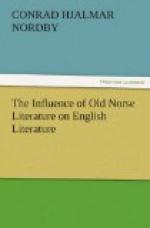Snorri’s work elicits from him repeated applause. Here, for instance, in Chap. X: “It has, all of it, the description (and we see clearly the fact itself had), a kind of pathetic grandeur, simplicity, and rude nobleness; something Epic or Homeric, without the metre or the singing of Homer, but with all the sincerity, rugged truth to nature, and much more of piety, devoutness, reverence for what is ever high in this universe, than meets us in those old Greek Ballad-mongers.”
SAMUEL LAING (1780-1868).
It was the work of Samuel Laing that gave Carlyle the material for this last-mentioned book.[18] Laing’s translation of Heimskringla bears the date 1844, and although Mr. Dasent’s quaint version of the Prose Edda preceded it by two years, The Sagas of the Norse Kings was the “epoch-making” book. It is true that a later version has superseded it in literary and scholarly finish, but Laing’s work was a pioneer of sterling intrinsic value, and many there be that do it homage still. Laing had the laudable ambition—so seldom found in these days—“to give a plain, faithful translation into English of the Heimskringla, unencumbered with antiquarian research, and suited to the plain English reader."[19] With this work, then, Icelandic lore passes out of the hands of the antiquarian into the hands of common readers. It matters little that the audience is even still fit and few; from this time on he that runs may read.
For our purpose it will not be necessary to characterize the translation. Laing commanded an excellent style, and he was enthusiastic over his work. Indeed, the commonest criticism passed on the “Preliminary Dissertation” was that the author’s zeal had run away with his good sense. Be that as it may, Laing called the attention of his readers to the neglect of a literature and a history which should be England’s pride, as Anglo-Saxon literature and history even then were. The reviews of the time made it appear as if another Battle of the Books were impending—Anglo-Saxon versus Icelandic; a writer in the English Review (Vol. 82, p. 316), pro-Saxon in his zeal, admitting at last that “of none of the children of the Norse, whether Goth or Frank, Saxon or Scandinavian, have the others any reason to be ashamed. All have earned the gratitude and admiration of the world, and their combined or successive efforts have made England and Europe what they are.”
It is refreshing to come upon new views of Old Norse character, that recognize “amidst anarchy and bloodshed, redeeming features of kindliness and better feeling which tell of the mingled principles that war within our nature for the mastery.” Laing’s translation accomplished this for English readers, and with the years came a deeper knowledge that showed those touches of tenderness and traits of beauty which, even in 1844, were not perceptible to those readers.




